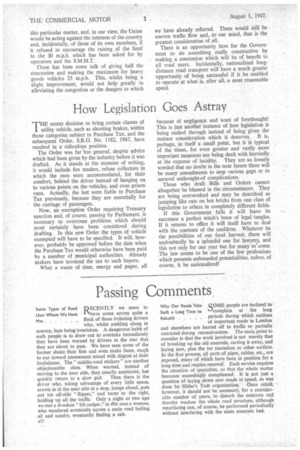Higher Speed Limit for Heavies?
Page 23

Page 24

If you've noticed an error in this article please click here to report it so we can fix it.
THE inconsistency of permitting the largest publicservice vehicle to travel at 30 m.p.h. and yet to restrict to 20•m.p.h. all goods vehicles weighing, unladen, over three tons, must have puzzled a great many people. Why should a coach or bus with its precious cargo of human beings be considered safer to operate at this higher speed than the goods vehicle? Even a vehicle in the heavy class, but built as a horsebox, is placed in the higher speed category.
We have argued this point on many previous occasions, over a long period of years, but return to it for the reason that it is now under consideration by the Ministry of Transport. It has also been the subject of certain questions in the House of Commons, these being, apparently, mainly designed to impede any move to equalize the limits for the two classes.
The main factors to be taken into account in investigating the pros and• cons of a possible concession for heavy goods vehicles may be considered as the effect generally upon safety; the attitude of the drivers concerned and those who represent them; and the economic aspect.
Advantages of a Higher Limit Dealing with these in the order mentioned, speed in this moderate range has very little to do with the prevalence of accidents. With commercial vehicles the majority of accidents, particularly where injury to pedestrians and other users of the road is concerned, and usually in the case of a bus, occurs at much lower speeds than the legal limit. Then there is the point as to whether goods vehicles in the heavy class are fit in respect of control, and, especially, braking power, to run at, say, 30 m.p.h. No manufacturer of a goods vehicle who is worth his salt would• turn out such a vehicle which in both these respects is not fully up to its work; in fact, most modern types could travel at a much higher rate and still be Under excellent control. The fact is that, law or no law, many of them already maintain average speeds which must mean travelling at well over 20 m.p.h. at times.
In our view, one of the most dangerous factors is inconsistency in traffic flow caused by vehicles with different speed limits operating together on the same track. This involves continual overtaking, which is a source of far more danger, particularly in congested areas, than would be created by allowing the heavier goods vehicles to proceed at the same rate as the general flow of traffic. Where there are variations in traffic speed, people are apt to take undue risks by running in front of slow-moving vehicles near the kerb and being caught by faster types overtaking. If the flow were made reasonably constant, this temptation would not exist.
Drivers Would Welcome Change Most drivers have found that running for long distances at the absurdly slow speed of 20 m.p.h. when they are in charge of modern vehicles, which can be classed as being amongst the finest of British products, is both boring and tiring, and even tends to encourage sleepiness; it also demands more gear changing, because the engines are not run at their greatest efficiency and hills are approached at too [ow an initial velocity, The whole object in operating the average heavy goods vehicle is to convey loads with the maximum efficiency, at reasonable cost, and as fast as conditions allow. In these respects the low maximum of 20 m.p.h. is entirely uneconomic not only as regards the actual vehicles concerned but for the reason that every slow vehicle is an additional focus of congestion, impeding all that other traffic which is permitted higher speeds. To put it in another way, its slow rate forces it automatically to occupy more road space during a certain period of time, and in this country we have not yet arrived at the stage at which we can afford to waste valuable highway area. There is, in fact, insufficient now, and with the growth of traffic, this condition will steadily worsen.
There is little doubt that the factors of low speed and resulting congestion cost trade and industry and, consequently, the whole Nation, a vast sum of money. They thus exercise a had influence upon the general price level of food and commodities.
The Transport and General Workers Union has been consulted by the Ministry of Transport on A21 . this particular matter, and, in our view, the Union would be acting against the interests of the country and, incidentally, of those of its own members, if it refused to encourage the raising of the limit to the 30 m.p.h, which has been asked for by operators and the S.M.M.T.
There has been some talk of giving half the concession and making the maximum for heavy goods vehicles 25 m.p.h. This, whilst being a slight improvement, would not help greatly in alleviating the congestion or the dangers to which we have already referred. There would still be uneven traffic flow and, to our mind, that is the greatest consideration of all.
There is an opportunity here for the Government to do something really constructive by making a concession which will be of benefit to all road users. Incidentally, nationalized longdistance road transport will have a much greater opportunity of being successful if it be enabled to operate at what is, after all, a most reasonable speed.












































































